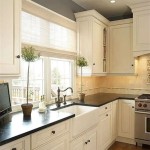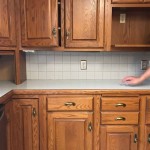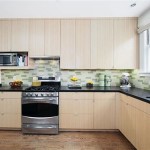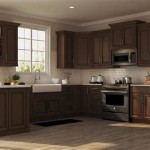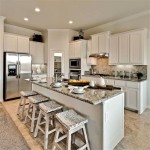Pickled Oak Kitchen Cabinets: A Comprehensive Guide
Pickled oak cabinets were a hallmark of kitchen design in the 1980s and 1990s. This finish, characterized by a light, almost whitewashed appearance, offered a distinct contrast to the darker wood tones popular in preceding decades. The pickling process involves applying a white or light-colored stain to oak wood, allowing the natural grain to show through while lightening the overall color. This technique creates a unique aesthetic, often described as rustic, cottage-style, or shabby chic.
The popularity of pickled oak cabinets has fluctuated over the years. While they fell out of favor for a period, replaced by darker, more contemporary styles, recent trends suggest a resurgence in appreciation for this classic finish. This renewed interest can be attributed to several factors, including the ongoing popularity of farmhouse and vintage-inspired design, as well as the desire for lighter, brighter kitchens.
Oak wood is a popular choice for cabinetry due to its durability and attractive grain patterns. It’s a hardwood known for its strength and resistance to wear and tear, making it well-suited for the demands of a busy kitchen. The open grain of oak also lends itself well to the pickling process, allowing the stain to penetrate deeply and highlight the natural wood texture.
The pickling process typically begins with preparing the oak surface. This may involve sanding to create a smooth, even base for the stain. Next, a white or light-colored stain is applied to the wood. The specific type of stain and application technique can vary depending on the desired final look. Some techniques involve applying a base coat of white paint followed by a layer of stain, while others use a specialized pickling stain designed to penetrate the wood and create a translucent effect.
After the stain has been applied, a sealant or topcoat is typically applied to protect the finish and enhance its durability. This sealant can be a clear varnish, polyurethane, or lacquer. The choice of sealant can impact the final appearance of the cabinets, with some options offering a glossy finish while others provide a more matte look.
Maintaining pickled oak cabinets requires regular cleaning and care. Dust and spills should be wiped up promptly to prevent staining or damage to the finish. Mild cleaning solutions, specifically designed for wood cabinetry, are recommended. Harsh chemicals and abrasive cleaners should be avoided, as they can damage the pickled finish. Periodically, the cabinets may benefit from a fresh application of sealant to maintain their protective layer.
Pickled oak cabinets offer considerable design versatility. They can be incorporated into a variety of kitchen styles, from traditional to contemporary. When paired with dark countertops and flooring, pickled oak cabinets can create a striking contrast that adds depth and visual interest to the space. Conversely, combining them with lighter surfaces can create a bright, airy atmosphere. Hardware choices also play a significant role in the overall aesthetic. Black or oil-rubbed bronze hardware can complement the rustic charm of pickled oak, while brushed nickel or chrome can create a more modern feel.
Choosing the right backsplash is another important consideration when designing a kitchen with pickled oak cabinets. Subway tile, beadboard, and patterned tiles can all complement the pickled finish. The color of the backsplash can be coordinated with the countertops and flooring to create a cohesive look. Natural stone, ceramic, and glass are all viable backsplash materials that can be paired with pickled oak.
Beyond aesthetics, there are practical considerations when choosing pickled oak cabinets. The light color can make dust and dirt more visible, requiring more frequent cleaning. Additionally, the pickled finish may be more susceptible to showing scratches and dents compared to darker finishes. However, these minor imperfections can also contribute to the overall aged, rustic charm that many find appealing.
While the resurgence of pickled oak cabinets signifies a renewed appreciation for vintage aesthetics, modern interpretations of this finish are also emerging. Techniques such as ceruse, which involves applying a contrasting color to the open grain of the oak, offer a contemporary twist on the traditional pickling process. This allows for greater customization and personalization, enabling homeowners to create unique and stylish kitchen designs.
The cost of pickled oak cabinets can vary depending on factors such as the quality of the wood, the complexity of the pickling process, and the manufacturer. Refacing existing oak cabinets with a pickled finish can be a more cost-effective option compared to installing entirely new cabinetry. This process involves applying a new veneer or laminate to the existing cabinet boxes, effectively transforming their appearance without the expense of full replacement.
Ultimately, the decision of whether or not to choose pickled oak cabinets depends on individual preferences and the overall design vision for the kitchen. The unique characteristics of this finish, combined with its design versatility, make it a compelling option for those seeking a classic, timeless, or subtly rustic aesthetic.

19 Pickled Oak Cabinets Ideas Kitchen Remodel

Wood N Finish Cabinet Kit Grained Pickled Oak Retique It

Sherwin Williams Functional Gray To De Pink Pickled Oak Cabinets Kitchen

Mauve Schmauve Reducing The Pink Of Pickled Oak Cabinets Table And Hearth

Pickled Oak Cabinets Has Me In A Pickle Over Wall Color

Limed Oak Cabinet Kitchens

Mauve Schmauve Reducing The Pink Of Pickled Oak Cabinets Table And Hearth

Wood N Finish Full Kitchen Countertop Kit Pickled Oak Retique It

Kitchen Cabinet Remake Pickled To Beachy Hometalk

How Do I Re Pickle Oak Kitchen Cabinets Is There An Easy Way Hometalk
Related Posts

